試管嬰兒 (IVF)
試管嬰兒是什麼?
試管嬰兒是以體外授精(In Vitro Fertilization,IVF) 來提高懷孕率的一種生殖醫學的治療方式,它是透過手術取出成熟卵子與篩選過的精子進行體外授精,經過實驗室3-5天的培養形成胚胎,再將胚胎植入子宮內使之繼續發育,以協助懷孕的生殖醫療技術。
試管嬰兒成功率
試管嬰兒成功率與年齡、精卵質量、胚胎品質、子宮等身體狀況因素有關。
根據國健署110年度人工生殖施行結果報告:
35歲試管嬰兒成功率:50%以上
37歲試管嬰兒成功率:50%以下
40歲以上試管嬰兒成功率:20%左右
星孕的試管嬰兒IVF療程懷孕率高達70%,每10對夫妻就有7對順利懷孕。
1. 排卵針搭配具有三度空間運算能力以及濾泡體積均值功能的超音波來增加卵子數量與卵子成熟率
2. 使用極細的取卵針及廣角高解析度定軸陰道超音波探頭導引
3. 使用特殊精蟲分離液去除精液中精漿及雜質,篩選出活動力最佳的精蟲進行受精
4. 特殊培養液做體外試管受精
5. 六軸機械顯微操作儀做精蟲顯微注射
6. 以精準調控氣體濃度模擬子宮內部環境的培養箱培養胚胎三到五天
7. 電腦定位的胚胎雷射做雷射輔助孵化
8. 利用胚胎黏著劑增加胚胎著床機會
9. 精準的超音波導引胚胎植入技術
10. 高劑量黃體補充法使子宮內膜與胚胎穩定連結與維持高體溫
星孕第三代試管嬰兒成功率達80%
星孕生殖醫學中心鍾繼賢院長長年致力於生殖內分泌暨不孕症、試管嬰兒及卵巢相關臨床領域,擅長腹腔鏡及子宮鏡手術,在婦科、產科、不孕症醫學三大領域都用心鑽研,提供個人化精準試管嬰兒療程,以第三代試管嬰兒胚胎著床前染色體篩檢(PGS)提高懷孕率至八成以上。
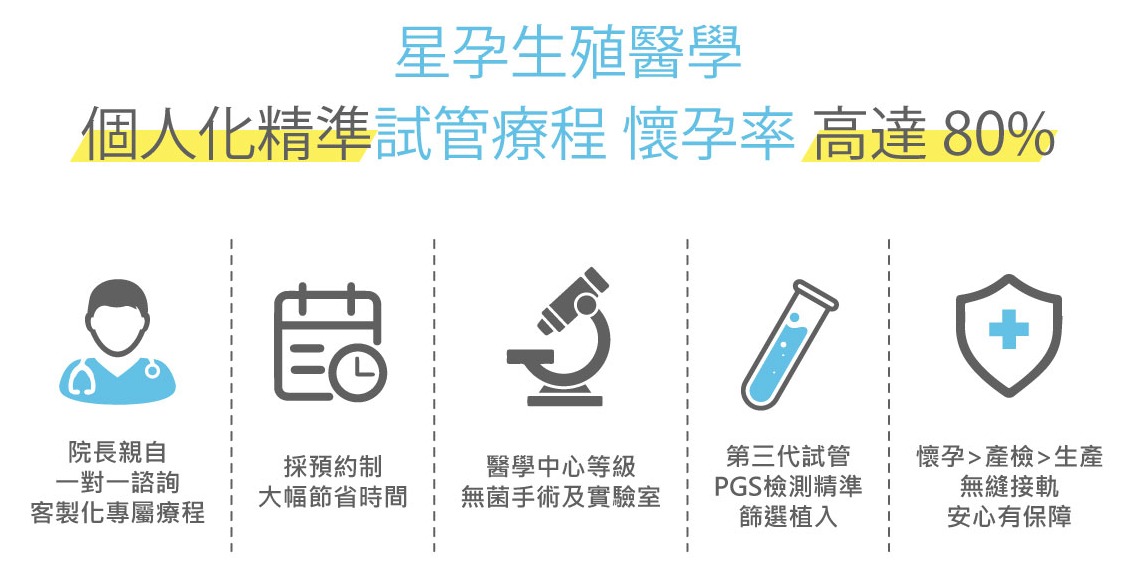
1. 【為您客製化量身打造孕育計劃 】
星孕幫助每對夫妻想當爸媽的願望,鍾繼賢院長依照夫妻雙方的身體狀況、生活習慣與過去的治療經驗,制定最佳的個人生育療程,讓您達成圓爸媽的夢。
2. 【預約制療程,不必等待】
現代人時間寶貴,因此我們採取預約制,讓您不必花長時間等候。透過預約制,不浪費時間,輕鬆享受貼心的就醫體驗。
3. 【醫學中心高等級設備】
手術室和實驗室設備,皆達醫學中心的無菌標準等級,確保每一步驟都在安全的環境中進行,提升了試管療程和胚胎培育的成功率,生寶寶的事請放心交給星孕。
4. 【精準第三代試管療程】
第三代試管技術PGS(胚胎著床前染色體篩檢)技術進行染色體篩選,確保植入的是最健康的胚胎。有效提高成功率,大幅降低流產風險。安心迎接健康的寶寶到來。
5. 【懷孕到生產的全程照護】
星孕幫助夫妻順利懷孕後,可安排至鍾婦產科給您生產的完整醫療服務,一條龍無縫接軌的孕育之路。每個階段的細膩照護,讓您從初次診療到寶寶誕生,都擁有高品質的醫療支持,讓整個孕育旅程更安心。
『醫學中心的醫療品質,社區診所的親民便利』 從細節中體現出我們對不孕症患者的細心關懷和專業承諾。
無論您在孕育路上遇到什麼挑戰,我們都會陪伴您,為您提供最佳的支持和協助
誰需要做試管嬰兒?
做試管嬰兒首要條件為在台灣具法定婚姻關係的異性夫妻,夫妻雙方有規律但未避孕的性行為達半年以上仍無法自然懷孕,建議可先至專業生殖中心做不孕症相關檢查,並與醫師討論最適合的療程方式。
試管嬰兒療程適應症
-3~4次人工受孕失敗者
-其他不明原因不孕症
-有染色體基因疾病家族史
女方
-年齡超過38歲|
-卵子庫存量減少(AMH 數值極低)
-雙側輸卵管阻塞或沾黏、中重度子宮內膜異位症
-習慣性流產
男方
-精蟲品質不佳或數量過少
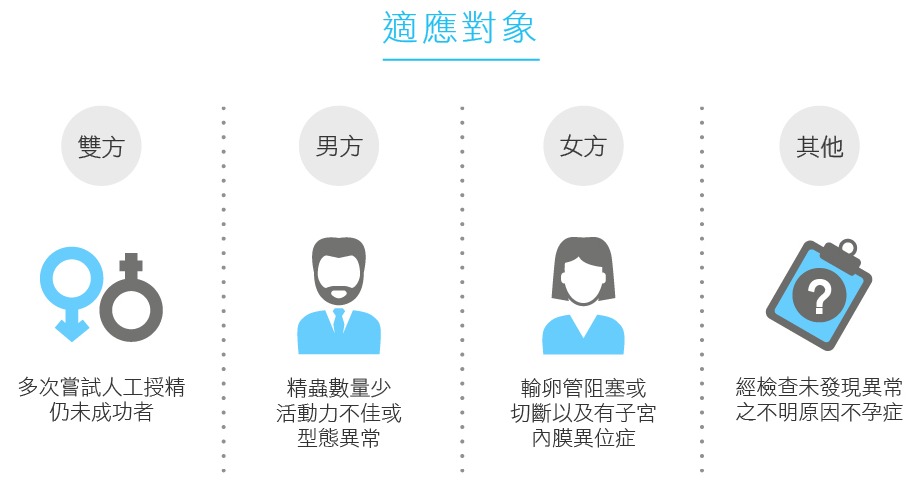
試管嬰兒費用
試管嬰兒療程的主要費用項目:
- 排卵針劑
- 取卵手術
- 受精
- 囊胚培養
- 冷凍與解凍胚胎
- 胚胎植入
試管嬰兒療程依據個人生育條件不同,如卵巢狀況、精子狀況,及對針劑藥品種類與劑量、取卵週期次數、胚胎培養技術、植入檢測選項等...會有費用上的差異。
第一代~第三代試管嬰兒介紹
第一代:自然受精(insemination)
-處理方式:將適量濃度的精子和卵子一起在培養皿中培養,精子們自然競爭和卵子結合
-成功率:20-30%
-適用對象:女性不孕,而男性精液分析正常且無精卵排斥問題
第二代:單一精蟲顯微注射(ICSI)
-處理方式:於高倍率顯微鏡下,挑選並以細玻璃針吸取活動力和型態都完美的精子,將精子注入卵子的細胞質裡面強迫受精
-成功率:50-60%
-適用對象:男性不孕,或女性採卵數少
第三代:單一精蟲顯微注射(ICSI)+ 胚胎著床前染色體篩檢(PGS)
-處理方式:進行試管嬰兒療程,採取培養至第5/6天囊胚的少量滋養層細胞,送至基因檢測公司針對染色體數目及小片段擴增與缺失等異常情形進行篩檢
-成功率:70%
-適用對象:女性及男性不孕、高齡(>35歲)生育者、習慣性流產的婦女、有染色體異常家族史的患者、試管嬰兒失敗二次以上者
第3.5代:單一精蟲顯微注射(ICSI)+ 胚胎著床前染色體篩檢(PGS)+子宮內膜容受性檢測(ERA)
-處理方式:採樣經外源性黃體藥物浸潤的一小部分子宮內膜,利用次世代基因定序(NGS) 分析與子宮內膜容受性相關的基因,檢測出最適合植入的時間。 於下一次療程,在精準時間植入染色體正常囊胚。
-成功率:最高可達 80%
-適用對象:<35歲植入一次未懷孕者、高齡(>43歲)生育者、相關檢查(如:輸卵管造影、子宮鏡檢查、自體免疫血液檢測) 皆正常,多次植入染色體正常囊胚未懷孕者
試管嬰兒流程
- 術前檢查:療程前,夫妻雙方評估生育功能。
- 誘導排卵:月經第2-3天抽血檢測進入療程,利用排卵藥物/針劑,刺激卵泡生長。
- 追蹤卵泡成熟度:藉助超音波監測卵泡發育,並且抽血檢驗追蹤血液中賀爾蒙的數值變化,以決定最佳取卵日。取卵日前36小時施打破卵針。
- 取卵與取精:採全身麻醉,經陰道超音波的導引下取出卵子,先生於取卵當日自行取精體外受精與胚胎培養。取出的卵子由實驗室處理及先生的精液經過洗滌選處理後,將卵子與精子以單一精蟲顯微注射(ICSI)或體外授精(Insemination)的方式進行受精,經過3-5天的培養形成胚胎。
- 解凍胚胎植入:選擇最佳的胚胎植入子宮內(其餘胚胎將冷凍保存),兩週後驗孕
*一次完整的試管嬰兒療程大約2個月的時間。
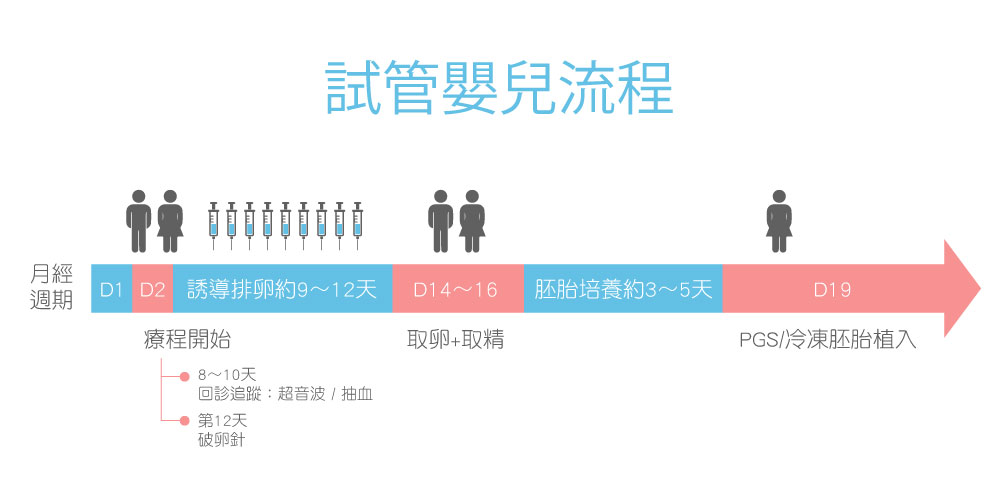
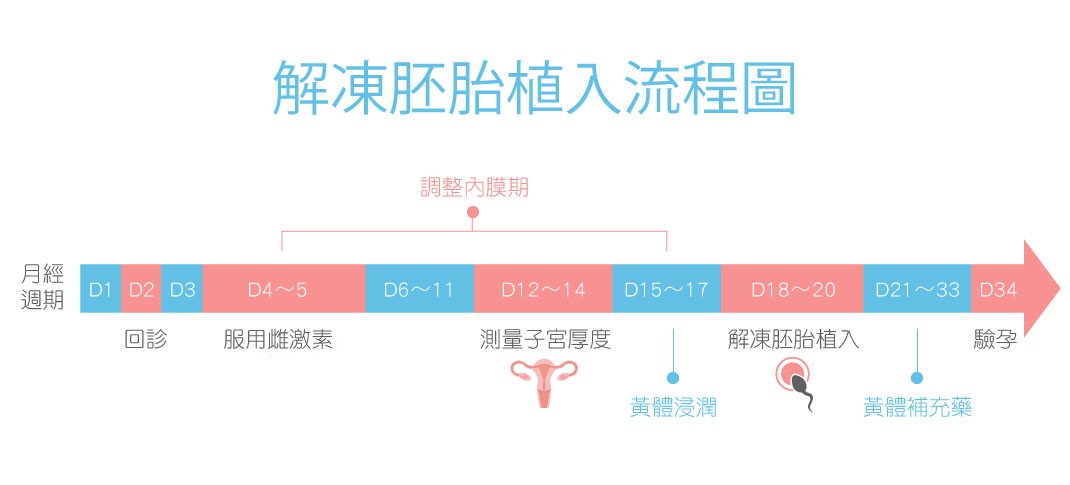
試管嬰兒補助
為了減輕不孕夫妻在人工生殖療程費用上的負擔,衛福部國健署提出的「擴大不孕症治療補助方案」於2021/07/01正式開跑囉!
試管嬰兒補助申請資格
1. 夫妻雙方至少一名為中華民國國籍
2. 太太年齡未滿45歲
3. 由生殖機構診斷為不孕夫妻,須接受試管嬰兒療程者
每胎申請次數上限
依太太第一次申請補助時的年齡:
39歲(含)以下,可申請6次
40-44 歲(含)以下,可申請 3 次
*補助費用為實支實付制
*確認申請資格後就可以開始療程,需在一年內完成療程,療程結束(懷孕確認或療程中止日)半年內完成申請。
試管嬰兒補助費用
非中低收入戶「首次」申請上限10萬元,「再次」申請上限6萬元。(依據胚胎植入和未植入,補助額度也不同)
中低收入戶「每次」補助上限15萬元
(不論是否為中低/低收入戶申請方式由機構代申請,線上審核)
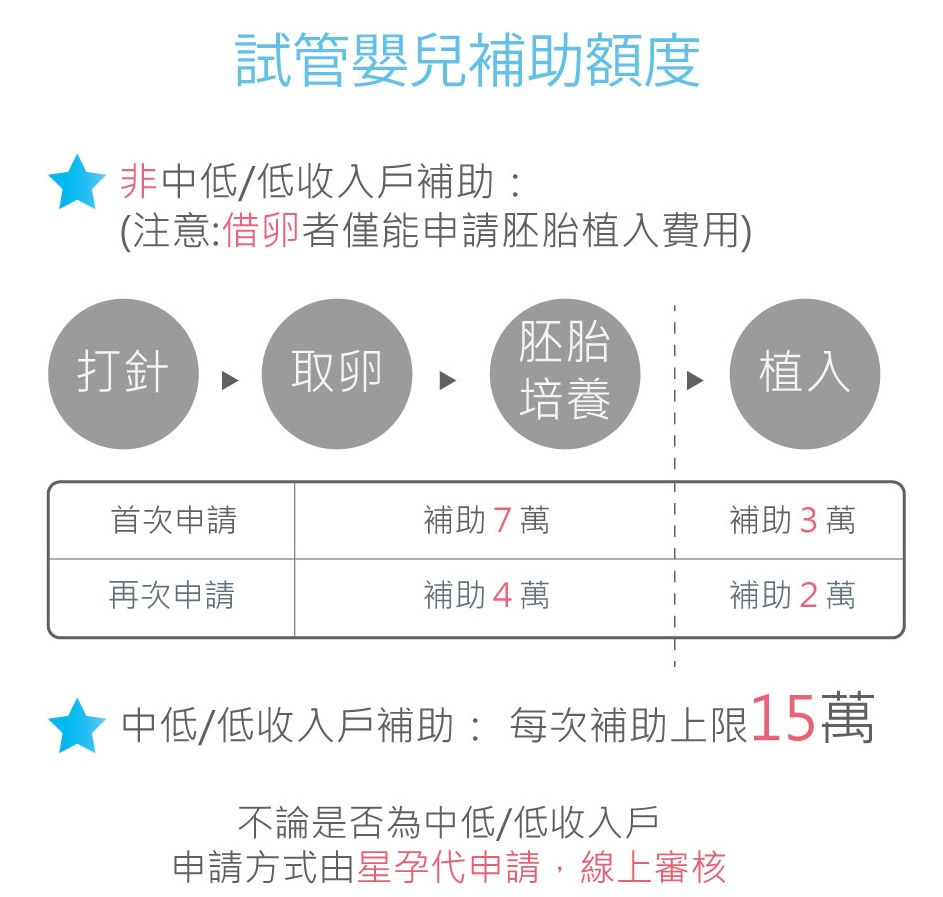
(延伸閱讀:試管嬰兒補助方案懶人包)
試管嬰兒療程前、中、後注意事項
開始療程前:
-均衡飲食:可以多吃抗氧化蔬果,以延緩精卵老化
-保健食品:DHEA、Q10+L-Carnitine、維生素D3、鋅 (可以與醫師討論建議補充劑量)
-戒菸酒
-正常生活作息:充足睡眠及避免熬夜
-規律運動:增強身體機能
-放鬆心情:減少壓力影響賀爾蒙
療程進行中:
-均衡飲食:可以多吃抗氧化蔬果,以延緩精卵老化
-保健食品:DHEA、Q10+L-Carnitine、維生素D3、鋅 (可以與醫師討論建議補充劑量)
-戒菸酒
-正常生活作息:充足睡眠及避免熬夜
-規律運動:增強身體機能
-放鬆心情:減少壓力影響賀爾蒙
-根據醫師囑咐用藥及施打針劑
胚胎植入後:
-補充黃體素以防早期流產
-在植入後至懷孕前三個月應避免性行為
-保持愉悅的身心及正常作息
-不需絕對臥床休息,適度運動,以增加血液循環
-避免劇烈運動、過度勞動或提重物
-避免泡溫泉,高溫不利胚胎發育(可以泡腳以促進血液循環)
-避免自行服用含中藥食補及食用刺激性食物、過量寒性食物、菸酒、咖啡、茶
-多補充新鮮蔬果、蛋白質食物
-胚胎植入後會安排兩次抽血,以確認胚胎著床狀況,懷孕6~7週時確認胚囊及心跳,並持續追蹤至12週,以確定胎兒正常發育。
-胚胎植入後第10~14天,可能出現微量「著床性出血」與下腹疼痛(「著床痛」),屬於正常狀態,但若出現異常鮮紅出血或劇烈腹痛,請迅速就醫!
試管嬰兒療程常見問題
1:試管嬰兒取卵後副作用有哪些?
卵巢過度刺激症候群(OHSS):少數人(3.3%)在使用排卵藥物刺激後,會因卵泡數量較多而出現強烈的刺激反應,導致發生腹脹、腹痛、口渴、噁心想吐、尿量減少、呼吸困難等症狀,大部分患者在短時間內就會恢復,極少數人若症狀較嚴重(0.17%)則需住院觀察。
2:如何選出等級好的囊胚,提升植入懷孕率?
囊胚(Blastocyst)指的是發育到第5~6天的胚胎,囊胚中會分化為2個部分,其中內細胞團(Inner Cell Mass)將發育為胎兒,滋養層細胞(Trophectoderm)將形成胎盤。 理想的情況下,試管療程會植入Day5的胚胎。而囊胚的等級,則是評估囊胚腔擴張程度、內細胞團與滋養層細胞等級,所組合成的一個數字+二個英文字母評分,如:4AA、5BC等。在臨床上,我們會選擇形成天數早、評分較佳的胚胎來進行植入,以提升懷孕率。
3:植入Day3的胚胎還是Day5的胚胎比較好 ?我適合植入第三天還是第五天的胚胎?
一般而言,不管是借卵/自胚植入,植入Day5的胚胎著床率及活產率皆較Day3的胚胎高。
Day5的胚胎是可以發育到囊胚的胚胎,因此著床率較高,適用於年紀較輕及取卵較多的患者。囊胚植入的胚胎數量比較少可降低多胞胎的機率,且可於培養過程中做胚胎著床前染色體篩檢(PGT-A,舊稱PGS)/基因診斷(PGT-M,舊稱PGD)。但要注意不是每個胚胎都可以長到第五天,要求植入Day5胚胎培養的病人有可能面臨第五天無胚胎可植入的困境。
Day3的胚胎通常適用於卵巢功能不佳,或取得卵子較少的患者。由於母體子宮的天然環境比體外的人工環境更好,因此對部份無法培養到第五天囊胚或發育程度不理想的胚胎,可在第三天的時候進行植入,一次植入多顆來提升懷孕成功率,從而改善胚胎發育狀況並提高著床成功率。
簡單來說,植入多顆Day3胚胎策略是走以量取勝的路線,植入Day5的胚胎就是高命中率的一擊即中。但一切都取決於母體卵子的數量及品質,胚胎植入前最好先諮詢醫師的專業意見。
| 項目 | Day 3 胚胎植入 | Day 5 囊胚植入 |
| 適用對象 | 卵巢功能不佳取卵數量較少的患者 | 年輕且具備良好的卵子數量和品質的患者 |
| 優點 | 植入母體子宮天然環境,有助改善胚胎發育狀況 | 胚胎發育良好可順利培養到第五天囊胚階段,懷孕成功率高 |
| 缺點 | 植入異常染色體胚胎的風險較高 | 並非所有胚胎都能發育到第5天,可能出現無胚胎可植入的情況 |
| 多胞胎風險 | 容易產生多胞胎,需注意風險 | 植入胚胎數量較少,多胞胎機率低 |
| 基因篩檢/診斷 | 無法進行胚胎染色體篩檢 (PGT-A) 或基因診斷 (PGT-M) | 可進行胚胎染色體篩檢 (PGT-A) 或基因診斷 (PGT-M) |
| 著床率/懷孕率 | 較低 | 較高 |
試管嬰兒成功案例
| 喜迎星孕雙胞胎寶寶 | 喜迎星孕雙胞胎寶寶 |
 |
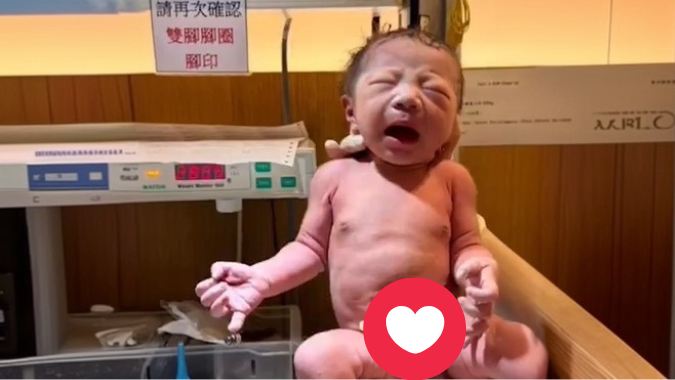 |
| 多囊成功懷孕,給不放棄的自己掌聲 | 備孕4年,IUI失敗2次,謝謝星孕終於懷孕成功了 |
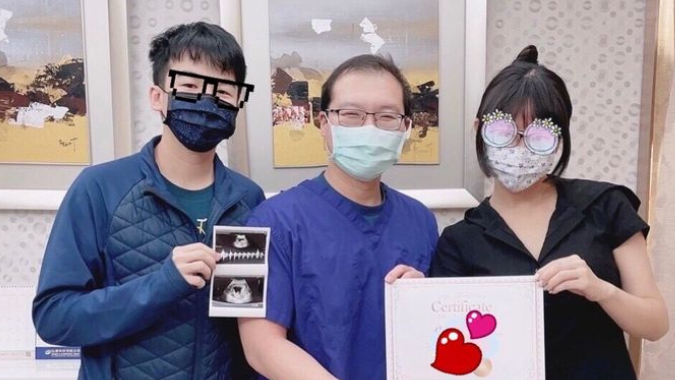 |
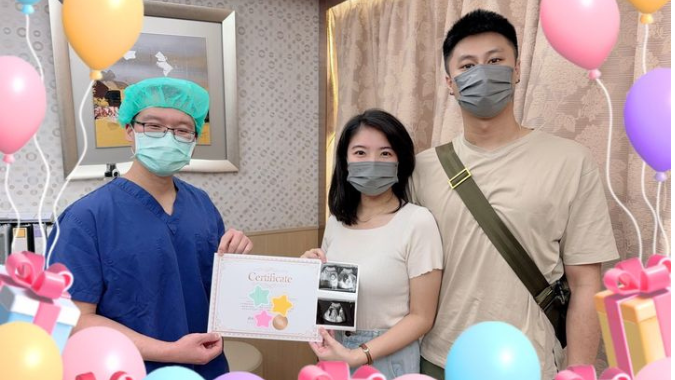 |


